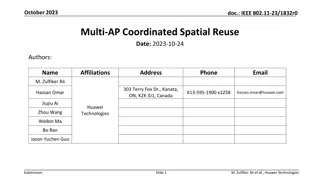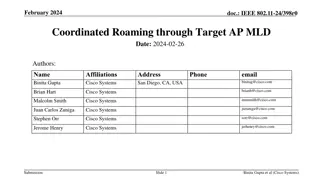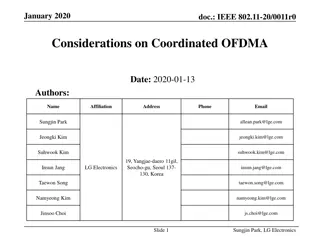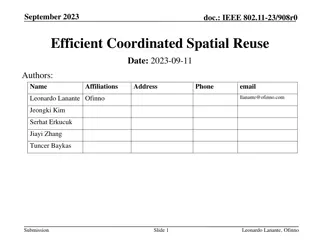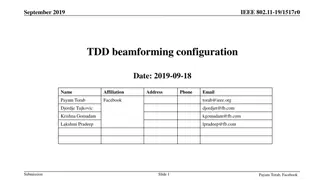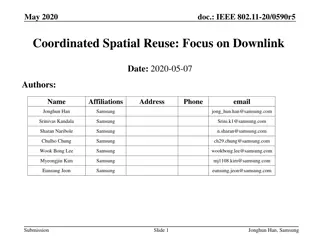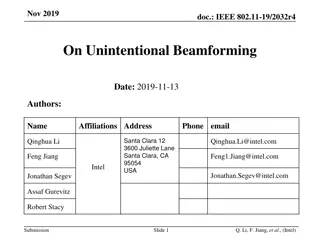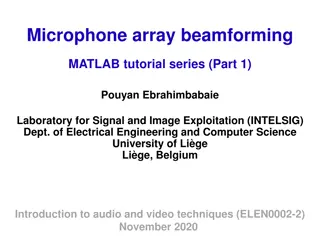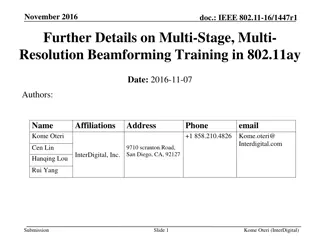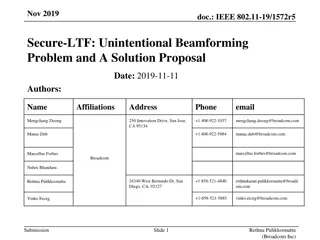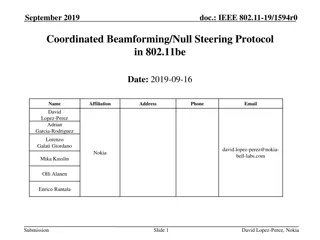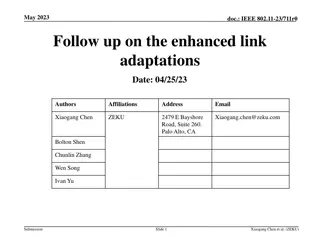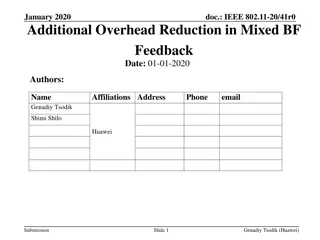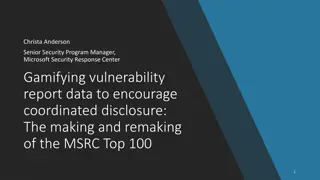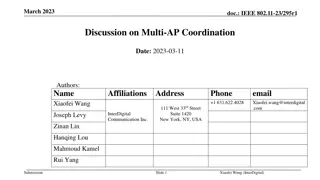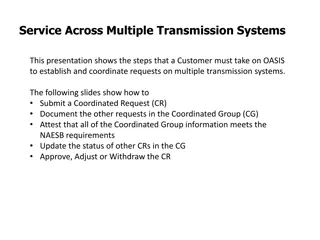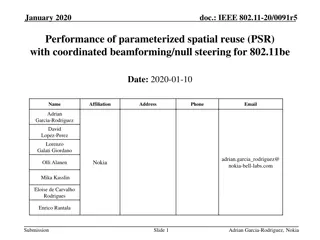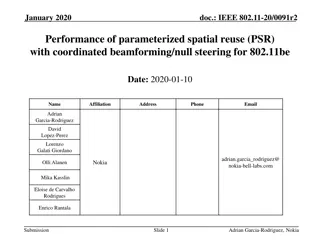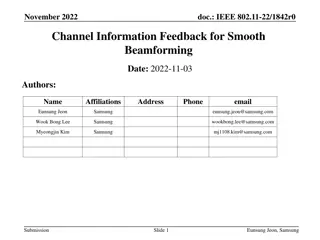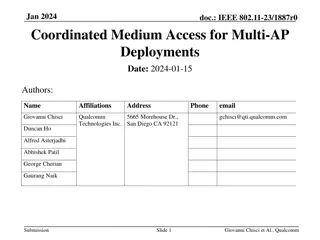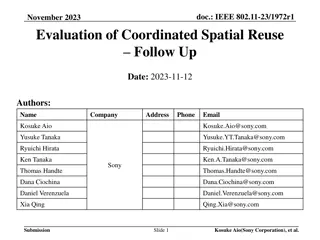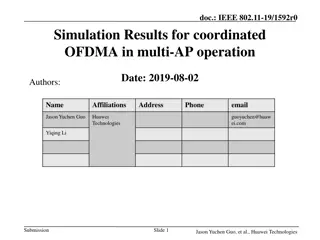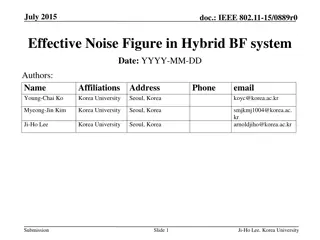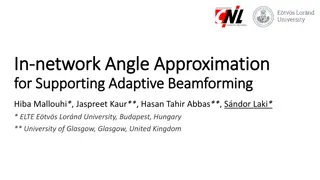Coordinated Spatial Reuse
Explore the concept of Coordinated Spatial Reuse (C-SR) in IEEE 802.11 networks, a scheme where multiple access points (APs) transmit data simultaneously to reduce interference and enhance resource utilization. Learn about the definition, benefits, and necessary components for successful C-SR operat
0 views • 15 slides
Coordinated Spatial Reuse in IEEE 802.11bn Standard
This contribution explores Coordinated Spatial Reuse (Co-SR) as a potential multi-AP feature for the IEEE 802.11bn standard. It discusses the trade-offs, proposes a method for downlink channel access, and evaluates its impact on goodput and packet delivery delay. The background highlights the gains
1 views • 17 slides
Understanding Coordinated Beamforming and MU-MIMO in IEEE 802.11-23/1998r0
This document delves into the intricacies of Coordinated Beamforming (Co-BF) and MU-MIMO techniques in the context of IEEE 802.11-23/1998r0 standard. It explores the concept of nulling in Co-BF, handling more Rx antennas than streams, Zero-Forcing precoding to eliminate Multi-User Interference (MUI)
2 views • 22 slides
Analysis of Power Control for Coordinated Spatial Reuse in IEEE 802.11-24
Evaluation of power control schemes for Coordinated Spatial Reuse (CSR) in IEEE 802.11-24, comparing benefits with and without power control. Results show gains in throughput and SINR with different CSR schemes and considerations for shared access points. Concerns and insights shared on the effectiv
6 views • 24 slides
Gain Analysis for Coordinated AP Transmissions in IEEE Enterprise R3 Network
This document discusses gain analysis results for coordinated AP transmissions in the IEEE Enterprise R3 network, focusing on tail latency gain for aperiodic traffic. Simulation setups, topology details, and results for different coordination schemes (C-TDMA, C-RTWT, and combined) are provided, show
5 views • 6 slides
Channel Information Feedback Enhancement for Improved Beamforming Performance
Beamforming plays a crucial role in achieving high throughput in wireless networks, but issues with discontinuity in beamforming lead to performance limitations. This document discusses the challenges with current beamforming practices and proposes a solution by increasing feedback overhead to enhan
2 views • 17 slides
ML-Aided Channel Classification for WLAN Optimization
The paper discusses using machine learning to classify IEEE channel models and improve WLAN performance. It demonstrates how neural networks can accurately classify channel types, leading to efficient beamforming and signal processing. Simulation results show the classification performance even at l
0 views • 12 slides
Thematic Working Group for Libya Flood Responses - Updates and Coordination Efforts
Thematic Working Group for Libya Flood Responses held a meeting on 17 October 2023 to discuss coordinated responses, targeting needs and damage assessments. Updates and documents published by partners after 10 October 2023 were shared, including reports from SRSG Abdoulaye Bathily and various agenci
0 views • 10 slides
Coordinated Roaming Proposal for IEEE 802.11 Networks
This document presents a proposal for coordinated roaming through target AP MLD in IEEE 802.11 networks to address connectivity disruptions due to sudden RSSI drops or STA transition scenarios. The solution aims to ensure data continuity, preserve context, and minimize data loss during roaming hando
0 views • 11 slides
Understanding Coordinated Entry System (CES) in Homeless Services
Coordinated Entry is a strategic approach focusing on housing and service coordination to link individuals experiencing homelessness to appropriate resources. With a primary goal of quick identification and prevention of homelessness, the system assesses consumer needs and connects them to housing a
0 views • 12 slides
Coordinated AP Time/Frequency Sharing in IEEE 802.11be
The document discusses Coordinated AP (CAP) Time/Frequency Sharing in Transmit Opportunity in IEEE 802.11be, focusing on Frequency and Time resource sharing between multiple APs in close proximity. It introduces concepts like CAP OFDMA and CAP TDMA, outlining the benefits in terms of latency improve
0 views • 15 slides
Considerations on Coordinated OFDMA Operation in IEEE 802.11
The document discusses the Coordinated OFDMA (C-OFDMA) operation as a part of Multi-AP coordination schemes within the IEEE 802.11 standard. It covers resource allocation options, topology considerations, resource allocation methods, capability announcement procedures, and negotiation processes betw
0 views • 15 slides
Understanding Multi-AP Operation in IEEE 802.11-20-0617/r3
Explore the basic definitions and key features of Multi-AP operation in the IEEE 802.11 standard. Learn about Multi-AP Candidate Set (M-AP-CS) and Multi-AP Operation Set (M-AP-OS) along with their participants and formation. Delve into the concepts of Coordinator AP, Coordinated AP(s), and reliable
0 views • 19 slides
Efficient Coordinated Spatial Reuse in IEEE 802.11-23
Coordinated Spatial Reuse (C-SR) is a Multi-AP transmission technique proposed for UHR networks that enhances efficiency by utilizing RSSI or pathloss feedback instead of complete CSI. This document introduces an efficient protocol for C-SR, focusing on a unified approach for better implementation.
0 views • 10 slides
Understanding IEEE 802.11-20/0410r4 Coordinated Spatial Reuse Procedure
This document presents the Coordinated Spatial Reuse (CSR) procedure in IEEE 802.11-20/0410r4, focusing on the transmission schemes and necessary information for effective spatial reuse. It outlines the topology of CSR environments, acquisition of information for CSR, CSR capability announcement by
8 views • 23 slides
Coordinated AP Time/Frequency Sharing in IEEE 802.11be
The document discusses the concept of Coordinated AP (CAP) Time/Frequency Sharing within a Transmit Opportunity (TXOP) in the IEEE 802.11be standard. It explains the procedures of Frequency and Time resource sharing, highlighting the benefits such as latency improvement and throughput fairness. Deta
0 views • 16 slides
IEEE 802.11-19/1517r0 TDD Beamforming Configuration Overview
IEEE 802.11-19/1517r0 discusses TDD beamforming operations related to Beam Measurement in the standard. Before Draft 4.0, these operations were primarily initiated by SME, causing limitations due to proprietary network controllers. The document reviews gaps and improvements in TDD beamforming, aimin
0 views • 10 slides
Coordinated Spatial Reuse in IEEE 802.11 Networks
The document discusses Coordinated Spatial Reuse (C-SR) in IEEE 802.11 networks, focusing on downlink transmission. C-SR is a multi-AP coordination scheme aimed at enhancing spectrum efficiency by reusing time/frequency resources among multiple Basic Service Sets (BSSs). The procedure is divided int
1 views • 24 slides
Unintentional Beamforming in IEEE 802.11-19/2032r4
Contribution on unintentional beamforming in IEEE 802.11-19/2032r4 addressing potential problems and solutions for secure ranging, involving issues with signal interference and power diminishing. Discussions include the impact on received power and robustness enhancements for signal transmission.
2 views • 10 slides
Introduction to Microphone Array Beamforming: MATLAB Tutorial Series
Explore microphone array beamforming techniques in this MATLAB tutorial series by Pouyan Ebrahimbabaie from the Laboratory for Signal and Image Exploitation at the University of Liège, Belgium. Learn about acoustic array geometry, signal processing, time-delay beamforming, and more to enhance audio
0 views • 27 slides
Coordinated Spatial Nulling (C-SN) Simulations in IEEE 802.11-24/0012r0
The document discusses the concept of Coordinated Spatial Nulling (C-SN) in IEEE 802.11-24/0012r0, focusing on spatial nulling feedback, synchronization needs, advantages of partial nulling, and comparison of half-coordinated versus fully coordinated scenarios. Simulation results are presented, anal
0 views • 19 slides
Enhancements in Multi-Stage Beamforming Training for IEEE 802.11ay
IEEE 802.11ay introduces improvements in beamforming training procedures for efficiency and MIMO support. The multi-stage, multi-resolution beamforming training framework enhances beamforming efficiency with high-resolution beams. The proposal includes a Sector Sweep frame and support for up to 2048
0 views • 19 slides
Unintentional Beamforming Issue in IEEE 802.11-19/1572r5 Secure-LTF Design
This document addresses a potential problem in the secure LTF sequence design of IEEE 802.11-19/1572r5, focusing on unintentional beamforming during multi-stream scenarios which can lead to dynamic range complications at the receiver. The proposal offers a solution to mitigate this issue by revising
0 views • 28 slides
Coordinated Beamforming/Null Steering Protocol in IEEE 802.11be
Coordinated beamforming/null steering is a promising scheme in IEEE 802.11be for joint transmission/reception challenges. This protocol aims to efficiently realize gains by establishing semi-static inter-AP coordination, enhancing spatial reuse opportunities, implementing CSI acquisition, and managi
0 views • 15 slides
Multi-Stage, Multi-Resolution Beamforming Training for IEEE 802.11ay
In September 2016, a proposal was introduced to enhance the beamforming training procedures in IEEE 802.11ay for increased efficiency and MIMO support. The proposal suggests a multi-stage, multi-resolution beamforming training framework to improve efficiency in scenarios with high-resolution beams a
0 views • 11 slides
IEEE 802.11-23/711r0 May 2023 Document Summary: Enhanced Link Adaptation Discussions
The May 2023 document IEEE 802.11-23/711r0 discusses topics like beamforming feedback, closed-loop rate adaptations, and issues related to beamforming feedback in a wireless communication context. It elaborates on the challenges of feedback optimization and post-SNR degradation, suggesting solutions
0 views • 15 slides
Techniques for Additional Overhead Reduction in Mixed Beamforming Feedback
Explore the properties of Mixed Beamforming (Mixed BF) and discover a method to reduce feedback size while maintaining high performance. Dive into the analysis of narrowband precoder properties to identify opportunities for size reduction without significant impact on total power. Enhance your under
0 views • 12 slides
Gamifying Vulnerability Reporting for Coordinated Disclosure at Microsoft Security Response Center
Christa Anderson, a Senior Security Program Manager at Microsoft's Security Response Center, discusses the importance of gamifying vulnerability report data to encourage coordinated disclosure. The MSRC Top 100, announced at Black Hat USA, plays a crucial role in the public credit strategy by recogn
0 views • 13 slides
Discussion on Multi-AP Coordination Architecture in IEEE 802.11-23
In this document, Xiaofei Wang from InterDigital Communication Inc. discusses the architecture required for multi-AP operations, seamless roaming support, and general MLD operation support in the context of IEEE 802.11-23 standards. The focus is on coordinating various operations across multiple APs
0 views • 9 slides
Coordinated Request Process on OASIS for Multiple Transmission Systems
This presentation guides customers on using OASIS to establish and coordinate requests on multiple transmission systems. It covers steps such as submitting a Coordinated Request (CR), documenting requests, attesting to NAESB requirements, updating statuses, and approving or adjusting requests within
0 views • 9 slides
Multi-AP Coordination for Low Latency Traffic Transmission
The document discusses the integration of multi-access point (AP) coordination to enhance the transmission of low-latency traffic in wireless networks. It addresses the challenges and introduces modes of operation capable of reducing latency and improving reliability for low-latency (LL) traffic tra
0 views • 9 slides
Performance Evaluation of Parameterized Spatial Reuse with Coordinated Beamforming for IEEE 802.11be
The study focuses on assessing the performance of parameterized spatial reuse (PSR) with coordinated beamforming/null steering for IEEE 802.11be. The framework allows coordinated sharing of uplink transmission opportunities among APs, demonstrating gains in synchronous coordinated beamforming system
0 views • 19 slides
Performance Evaluation of Coordinated Beamforming with Parameterized Spatial Reuse in IEEE 802.11be
The document discusses the performance evaluation of coordinated beamforming with parameterized spatial reuse (PSR) in IEEE 802.11be. It explores the practical operation of the 802.11ax PSR framework with null steering and the key implementation benefits, emphasizing unsynchronized operation and ada
0 views • 20 slides
Channel Information Feedback for Beamforming Enhancement
Beamforming is essential for achieving high throughput in wireless communication, but it still requires improvements, especially when combined with channel smoothing techniques. This document discusses the challenges of discontinuities in beam-steering matrices and proposes a feedback mechanism for
0 views • 13 slides
Smooth Beamforming with Feedback Overhead Reduction in IEEE 802.11-23
This document discusses a method for reducing feedback overhead in smooth beamforming to optimize phase rotations for V matrix in IEEE 802.11-23 standard. It explores V matrix optimization, column-wise phase shift, and beamformer side optimization to achieve channel smoothing gain at the receiver si
0 views • 14 slides
Coordinated Medium Access for Multi-AP Deployments in IEEE 802.11 Networks
The document discusses a solution to reduce latency, increase throughput, and improve reliability in networks with latency-sensitive traffic by introducing coordination between access points (APs). This involves leveraging mechanisms like Restricted TWT (rTWT) and Coordinated rTWT (C-rTWT) to facili
0 views • 12 slides
Evaluation of Coordinated Spatial Reuse in Multi-AP Scenarios for IEEE 802.11-23/1972r1
Evaluation of Coordinated Spatial Reuse (SR) in a 4AP scenario for IEEE 802.11-23/1972r1 in November 2023. The study focuses on improving throughput in multiple BSS environments through coordinated SR. The simulation parameters include AWGN channel, pathloss exponent, noise figure, and other key fac
0 views • 15 slides
Simulation Results for Coordinated OFDMA in Multi-AP Operation
Multi-AP operation, specifically Coordinated OFDMA, is evaluated through system-level simulation results in a two-BSS scenario. The performance metrics include burst throughput and delay in a burst traffic model. Transmission procedure involves two APs sharing 160MHz bandwidth. The study aims to sho
0 views • 9 slides
Noise Figure Analysis in Hybrid Beamforming Systems
This document discusses the theoretical study of noise figure (NF) and gain in hybrid beamforming systems, focusing on the impact of additional RF blocks, such as phase shifters and combiners, on noise figure calculations. It explains how the received signals from multiple antennas are phase-correct
0 views • 11 slides
Beamforming in mmWave Transmission for 5G Networks
Adaptive beamforming plays a vital role in supporting mmWave transmission in 5G networks, addressing challenges like high propagation loss and signal blockage. The use of an innovative user-assisted approach, involving angle computation and configuration messages, enhances the beamforming process fo
0 views • 18 slides

